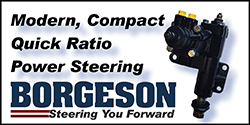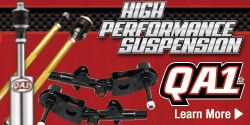robertodonnell
Well-Known Member
Hi everyone,
I have a mildly tuned 318 in my '65 Valiant, and I'm wanting to dial in my AFR in the light cruise area better. Carb is a standard 600 vac secondary Holley list 80457.
At this stage, the car is running very well, auto choke working properly and the car runs without any bog or lean/rich stumbling. Mash the pedal and she runs smoothly to redline from any gear (T5 manual). But, it runs rich (12.5 - 13) in light cruise.
I know that the main jets don't come on until well after 2000 RPM, and as I run a final drive where I'm turning about 2000 revs at 65 MPH, I need to tune the idle/transition circuit to get in the mid 14's. Today I tried some wire in the Idle Feed Restrictors, but all this did was serve to make my idle so lean that I needed to back out the mixture screws to get my idle back in the mid 13's where it idles best, and then my light cruise was back in the 12.5 to 13 range again.
If I lean my idle to a nearly impossible 16:1, I get my light cruise in the low to mid 14's. The car is undriveable off idle, and naturally is a pig at the lights.
So, how do I get my idle AFR in the mid 13's, and my light cruise in the mid 14's? I am thinking it's time to work on the Air Bleeds, but I'm not sure.
I've been reading the Yellowbullet Forums, and the Burton Machine tuning sheet, amongst all the other Google results, but I am hoping someone on here has done similar and can suggest a path forward.
I've also been on the Holley forums, but there is very little activity there, and lots of threads with 0 replies.
I have a spare 4160 that I can work on, so drilling the bleeds isn't the end if I stuff up.
Thanks is advance guys, cheers.
Robert
I have a mildly tuned 318 in my '65 Valiant, and I'm wanting to dial in my AFR in the light cruise area better. Carb is a standard 600 vac secondary Holley list 80457.
At this stage, the car is running very well, auto choke working properly and the car runs without any bog or lean/rich stumbling. Mash the pedal and she runs smoothly to redline from any gear (T5 manual). But, it runs rich (12.5 - 13) in light cruise.
I know that the main jets don't come on until well after 2000 RPM, and as I run a final drive where I'm turning about 2000 revs at 65 MPH, I need to tune the idle/transition circuit to get in the mid 14's. Today I tried some wire in the Idle Feed Restrictors, but all this did was serve to make my idle so lean that I needed to back out the mixture screws to get my idle back in the mid 13's where it idles best, and then my light cruise was back in the 12.5 to 13 range again.
If I lean my idle to a nearly impossible 16:1, I get my light cruise in the low to mid 14's. The car is undriveable off idle, and naturally is a pig at the lights.
So, how do I get my idle AFR in the mid 13's, and my light cruise in the mid 14's? I am thinking it's time to work on the Air Bleeds, but I'm not sure.
I've been reading the Yellowbullet Forums, and the Burton Machine tuning sheet, amongst all the other Google results, but I am hoping someone on here has done similar and can suggest a path forward.
I've also been on the Holley forums, but there is very little activity there, and lots of threads with 0 replies.
I have a spare 4160 that I can work on, so drilling the bleeds isn't the end if I stuff up.
Thanks is advance guys, cheers.
Robert
















